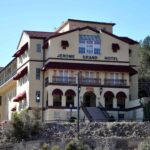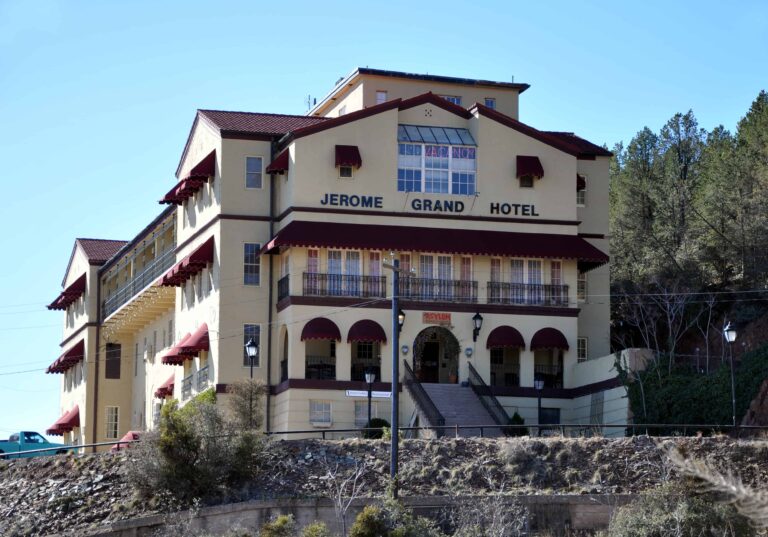Discovering Arizona’s Abandoned: Ghost Towns
Ghost towns are remnants of the past, frozen in time and abandoned by their inhabitants. They serve as a window into history, offering a glimpse into the lives of those who once called these towns home. Arizona, with its rich history and abundance of natural resources, is home to numerous ghost towns that tell the story of the state’s past. From mining towns to agricultural communities, these abandoned settlements offer a unique perspective on Arizona’s development.
Arizona’s unique history and geography have contributed to the proliferation of ghost towns throughout the state. The discovery of gold and other valuable minerals in the late 19th century led to a mining boom in Arizona, attracting thousands of prospectors and settlers. As mining operations grew, so did the towns that supported them. However, as the resources were depleted or mining operations became unprofitable, these towns were gradually abandoned, leaving behind empty buildings and a sense of nostalgia.
History of Arizona’s Mining Industry and its Impact on Ghost Towns
The rise and fall of Arizona’s mining industry played a significant role in the creation of ghost towns. In the late 19th century, Arizona experienced a mining boom as prospectors flocked to the state in search of gold, silver, copper, and other valuable minerals. Towns sprang up around these mining operations, providing housing, services, and entertainment for the miners and their families.
However, as the mines were depleted or became unprofitable, many of these towns began to decline. The once-thriving communities were left deserted as people moved on in search of new opportunities. Today, these ghost towns stand as a testament to Arizona’s mining heritage and the boom-and-bust cycles that shaped the state’s economy.
Examples of famous mining towns turned ghost towns in Arizona include Jerome, Bisbee, and Tombstone. Jerome was once known as the “Wickedest Town in the West” due to its rowdy reputation and booming copper industry. However, as the mines closed and the population dwindled, Jerome became a ghost town. Today, it has been revitalized as an artist community and tourist destination, with many of its historic buildings preserved.
Bisbee, located in southeastern Arizona, was once a thriving mining town known for its rich copper deposits. At its peak, Bisbee was the largest city between St. Louis and San Francisco. However, as the demand for copper declined, so did the town’s fortunes. Today, Bisbee is a popular tourist destination known for its well-preserved Victorian architecture and vibrant arts scene.
Tombstone, famous for the gunfight at the O.K. Corral, was once a bustling silver mining town. However, after the silver mines were depleted, Tombstone went into decline and became a ghost town. Today, it is a popular tourist attraction that attracts visitors from around the world who come to experience the Wild West history of the town.
Exploring Arizona’s Forgotten Towns: A Guide for Adventure Seekers
For adventure seekers and history enthusiasts, exploring Arizona’s ghost towns can be an exciting and rewarding experience. However, it is important to approach these sites with caution and respect for their historical significance.
When visiting ghost towns, it is essential to prioritize safety. Many of these towns are located in remote areas and may have unstable structures or hidden hazards. It is advisable to wear sturdy shoes and bring plenty of water and sunscreen, as well as a map or GPS device to navigate the area.
There are several popular ghost towns in Arizona that are easily accessible and offer a glimpse into the state’s past. One such town is Oatman, located on historic Route 66. Oatman was once a thriving gold mining town but declined after the mines closed. Today, it is known for its wild burros that roam the streets and its Old West charm.
Another popular destination is Goldfield Ghost Town, located near Apache Junction. Goldfield was a gold mining town in the late 19th century but was abandoned after the mines were depleted. Today, it has been restored as a tourist attraction, with shops, museums, and a narrow-gauge railroad.
For those seeking a more off-the-beaten-path experience, there are numerous lesser-known ghost towns scattered throughout Arizona. These towns may require more effort to reach but offer a more authentic and secluded experience. Some lesser-known ghost towns include Ruby, a former mining town in southern Arizona, and Swansea, a copper mining town near the California border.
The Haunting Tales of Arizona’s Ghost Towns: Stories and Legends
| Chapter | Ghost Town | Story | Legend |
|---|---|---|---|
| 1 | Tombstone | The Gunfight at the O.K. Corral | The ghosts of the cowboys still roam the streets at night |
| 2 | Jerome | The Haunted Hamburger | The ghost of a miner who died in a mining accident haunts the restaurant |
| 3 | Bisbee | The Copper Queen Hotel | The ghost of a prostitute who was murdered in the hotel still lingers in room 315 |
| 4 | Oatman | The Oatman Massacre | The ghosts of the murdered settlers can still be heard screaming in the canyon |
Ghost towns are often associated with tales of the supernatural and paranormal activity. Arizona’s ghost towns are no exception, with many stories and legends surrounding these abandoned settlements.
One of the most famous ghost stories in Arizona is that of the Bird Cage Theatre in Tombstone. The Bird Cage Theatre was once a popular saloon and gambling hall, known for its wild parties and gunfights. It is said to be haunted by the spirits of those who died there, with reports of ghostly apparitions and strange occurrences.
Another haunted ghost town in Arizona is Jerome. The town is rumored to be haunted by the spirits of miners who died in accidents or from diseases such as tuberculosis. Visitors have reported hearing strange noises, seeing apparitions, and feeling a sense of unease while exploring the town.
The allure of ghost towns for paranormal enthusiasts is undeniable. Many people are drawn to these abandoned settlements in search of evidence of the supernatural. Whether it is capturing an EVP (electronic voice phenomenon) or experiencing a chilling encounter, ghost towns offer a unique opportunity to explore the unknown.
Preserving Arizona’s Abandoned Ghost Towns: Efforts and Challenges
Preserving Arizona’s ghost towns is essential for maintaining the state’s historical heritage and ensuring that future generations can learn from these abandoned settlements. However, there are several challenges associated with preserving ghost towns.
One of the main challenges is the remote location of many ghost towns. These towns are often located in remote areas with limited access, making it difficult to maintain and protect the structures. Additionally, the harsh desert climate of Arizona can take a toll on the buildings, causing them to deteriorate over time.
Despite these challenges, there have been successful preservation efforts in Arizona. The town of Jerome, for example, has been revitalized as an artist community and tourist destination. Many of its historic buildings have been restored and are now used as galleries, shops, and restaurants.
Another example is Goldfield Ghost Town, which has been restored and transformed into a tourist attraction. The town’s buildings have been preserved and now house shops, museums, and a theater.
The Architecture and Design of Arizona’s Ghost Towns: A Reflection of the Past

The architecture and design of Arizona’s ghost towns offer a glimpse into the past and reflect the time period in which they were built. From Victorian-style homes to rustic mining structures, these buildings tell the story of Arizona’s history.
In mining towns such as Bisbee and Jerome, many of the buildings were constructed using locally sourced materials such as adobe or wood. These structures often feature ornate details and decorative elements that were popular during the late 19th century.
In agricultural communities such as Ruby, the architecture is more utilitarian, with simple structures designed for practicality rather than aesthetics. These buildings often feature large windows to maximize natural light and ventilation.
One notable example of architecture in Arizona’s ghost towns is the courthouse in Tombstone. Built in 1882, the courthouse is a prime example of Victorian-era architecture with its ornate detailing and grand facade.
Arizona’s Ghost Towns and their Role in the Wild West Era
Ghost towns played a significant role in the Wild West era, contributing to the development of the American West. These towns were often located near mining or cattle ranching operations and served as hubs for economic activity and social interaction.
In the late 19th century, the American West was characterized by lawlessness and a sense of adventure. Ghost towns such as Tombstone and Bisbee were at the center of this era, with their saloons, gambling halls, and gunfights.
Tombstone, in particular, is famous for the gunfight at the O.K. Corral, which took place in 1881. The gunfight was a result of a long-standing feud between two factions in the town and has since become an iconic event in American history.
Abandoned Mines and the Environmental Impact on Arizona’s Ghost Towns
Abandoned mines have had a significant environmental impact on Arizona’s ghost towns. Many of these mines were operated without proper environmental regulations, leading to pollution and degradation of the surrounding land.
Mining practices of the past often involved the use of toxic chemicals such as mercury and cyanide, which were used to extract gold and other minerals from ore. These chemicals were often released into nearby water sources, contaminating them and posing a threat to wildlife and human health.
Additionally, abandoned mines can pose physical hazards such as open pits or unstable structures. These hazards can be dangerous for both humans and wildlife, making it essential to clean up and secure these sites.
Efforts have been made to clean up abandoned mines in Arizona and mitigate their environmental impact. The Arizona Department of Environmental Quality (ADEQ) oversees the cleanup of abandoned mines and works to ensure that these sites are safe for public use.
The Economic and Social Factors Contributing to Arizona’s Ghost Towns
Several economic and social factors contributed to the rise and fall of ghost towns in Arizona. Changes in the economy and society played a significant role in the decline of these once-thriving communities.
One economic factor that contributed to the decline of ghost towns was the depletion of natural resources. Many of these towns were built around mining operations, and when the resources were exhausted or became unprofitable, the towns went into decline.
Another economic factor was the development of new industries and technologies. As new industries emerged, such as manufacturing and technology, people moved away from rural areas in search of better job opportunities. This led to a decline in population and the abandonment of many small towns.
Social factors also played a role in the decline of ghost towns. Changes in societal norms and values, such as the shift towards urbanization and the decline of traditional industries, contributed to the decline of rural communities.
The Legacy of Arizona’s Abandoned Ghost Towns and their Importance in History
Arizona’s abandoned ghost towns are more than just empty buildings and forgotten streets. They are a testament to the state’s rich history and offer a unique perspective on Arizona’s development.
These ghost towns provide a glimpse into the lives of those who once called them home, offering valuable insights into the past. They serve as a reminder of the boom-and-bust cycles that shaped Arizona’s economy and the challenges faced by those who settled in these remote areas.
Preserving these ghost towns is essential for maintaining Arizona’s historical heritage and ensuring that future generations can learn from these abandoned settlements. By exploring these towns, we can gain a deeper understanding of Arizona’s past and appreciate the legacy left behind by those who came before us.


